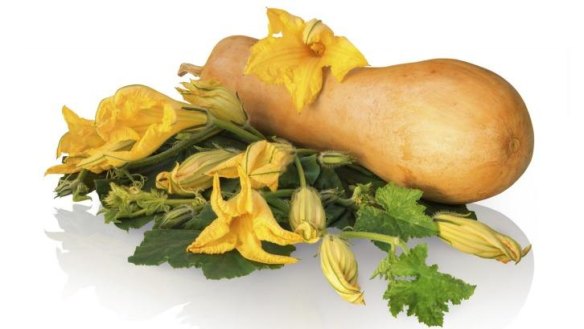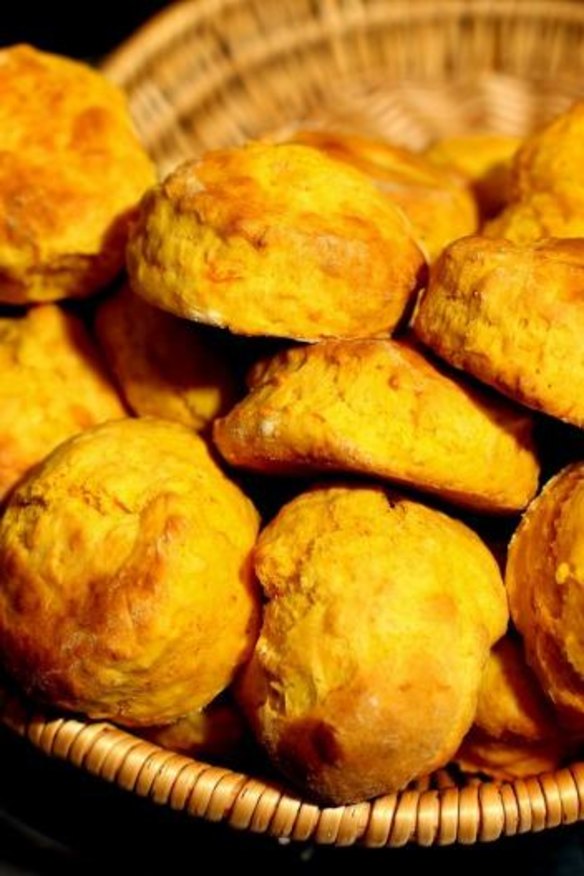Growing pumpkins in Canberra

Pumpkins are one of those crops where everything essential is underground. There are few vegetables that rely so much on the quality of the "under layers". It is what lies beneath the soil surface that will determine the size of any pumpkin crop, apart from water and plenty of sunshine, of course.
You may have seen how well a pumpkin vine can grow when a seed has been left to emerge out of a compost heap. So it is worth trying to replicate the qualities of a fully decomposed compost heap. A tried and tested method is to excavate a hole to 35-40 centimetres deep and about 1 metre in diameter, to form a crater with a rim of good soil. Fill in the hole with lots of compost, old manures and even some leaf mould. Then cover with 10 centimetres of garden soil.
If you have sufficient space, prepare several mounded holes, leaving at least 50 centimetres between the outer rims of each mound. Plant three pumpkin seeds or pre-grown seedlings into each mound, spaced well apart. Water them in well and if you know a hot day is on its way, place a large pot or bucket over the little plants for a couple of days to allow the plants to settle in..

It is important to know that the roots of pumpkin plants can grow outwards for one metre and more, if they have the right micro-environment. With the leaves of the pumpkin spreading out to 3-4 metres above ground, the large root systems need lots of good, organic matter to supply the required level of nutrients.
When the pumpkins spread out across the garden, they will produce many large leaves that will act to shade the ground beneath. The plants will need to be well watered on a regular basis.
Pollination is required, either by bees or by hand. Each plant will produce both male and female flowers which open quite early in the day. Pollination of the female flowers needs to occur within a couple of days, or it is too late. If you do not observe bees hovering around the plants, take a little paintbrush and go out in the early morning to collect some pollen from male flowers and brush the stamen of the female flowers.
You now have such a range of pumpkins to select from and quite a number have been bred in Australia. The Queensland Blue is a long-time favourite of gardeners with big gardens. Its vines will spread out across a big area and it can produce several pumpkins per plant, if everything aligns well. It is one of the good, long-keeping varieties, with its thick skin. It will take close to five months till they are ready to be harvested.
Jarrahdale and Jap pumpkins also belong to the "grey family" of pumpkins but they mature slightly faster than the other large varieties. Jarrahdale was bred in Western Australia and you can expect 1 or 2 pumpkins per vine. Jap can, however, produce 3-4 pumpkins on each vine. The skin of both of these pumpkins is quite thin, the flesh is bright orange and quite sweet. They can weigh up to 7 kilograms but if the season is hard will weigh in between four and six kilograms.
There are a number of very interesting, ribbed-shaped pumpkins on the market now. Australian Butter is a heirloom variety which will produce tan-coloured skin pumpkins with deep orange, dense flesh. The size can be up to 7 kilograms and it is excellent for baking. The Australian Ironbark pumpkin is quite large and somewhat flat with thick bumpy dark green skin. The deep orange inside tastes wonderful and it is a pumpkin that will store well.
Musquee de Provence is a French heritage variety which produces very distinct ribs. Its skin is tan coloured and the flesh is deep orange. It will take 5 months to mature but with its thick skin it will store well over winter. One of the most amazing looking French-origin pumpkins is the elegant Galeux D'Eysines with salmon-pink coloured skin which appears with peanut shell-like warts all over it. The warts are caused by sugar in the skin, as it ripens. The flesh of this pumpkin is sweet and moist and is great for baking and for soups. It can be 5-6 kilograms in size and it will store for up to 6 months.
The other wonderful French pumpkin is the Rouge vif d'Etampes (often called the Cinderella pumpkin) with its beautiful smooth, bright orange skin. It can grow into quite a large pumpkin and takes on the appearance of a Dutch gouda cheese wheel. This is highly sought after by producers of pumpkin soup because of the smoothness of its flesh.
Marina di Chioggia is a very old, Italian heirloom with thick, knobbly grey-green skin which keeps well. The fruit is sweet and rich deep yellow-orange. It is excellent both for baking and for soup making.
The well-known butternut pumpkin is the main bell shaped variety with dark orange sweet flesh. It has thin skin and a small seed cavity. It actually is one of the longest growing periods but it can be stored for some months over winter.
If you have very limited space, you can grow the little golden nugget pumpkin. It yields a crop in just three months. It is a bush plant, growing in a similar fashion to the zucchini plant. You can often get 10-15 little pumpkins appearing on each plant. They will only grow to 10-12 centimetre round balls and the flesh in not thick. However, it grows quickly and is an excellent pumpkin to add to a baked dinner. Baby Blue is another bush pumpkin with thin grey skin and sweet orange flesh. The size is only 20 centimetres in diameter but it is a very good alternative for small gardens.
Pumpkin scones
¼ cup castor sugar
40g softened butter
cup cooked pumpkin, mashed
large free range egg
2½ cups SR flour
½ teaspoon cinnamon
¼ teaspoon nutmeg
pinch of salt
Preheat the oven to 200C. Beat the sugar and butter together then add the mashed pumpkin and mix in well. Add in the egg and beat into the mixture. Sift the flour with the cinnamon, nutmeg and a pinch of salt. Then fold these dry ingredients into the pumpkin mix, adding in some of the milk. If the final mixture seems a little dry, add a little more milk until you have a soft dough.
Place the dough onto a floured surface and lightly knead until smooth. Then gently roll the dough out until it is 2 cm thick. Cut scones with a scone cutter and glaze them with a little milk. Bake for 12-14 minutes, until they are golden brown. Place onto a wire rack to cool.
This week in the garden
Plant sweet corn, bush beans, silver beet, spinach and zucchini directly into garden beds.
Plant out potatoes that have been well chitted (shoots allowed to develop) into trenches and cover. Hill up when the first shoots emerge.
Plant seeds of brussels sprouts or cabbage into propagation trays for later crops.
Give all your established vegetables a regular foliar watering with diluted seaweed or fish emulsion liquid fertilisers.
Check stone fruit trees for heavy fruit setting and thin back to 2 or 3 per hand width.
If you have any residual leaf curl on peach or nectarine trees, allow those leaves to dry up and shrivel, then carefully remove and dispose of them. New leaves will emerge with no fungal problems.
Prune off any frost-affected leaves from your citrus trees where there is evidence of white scale.
Owen Pidgeon runs the Loriendale Organic Orchard near Hall.
Restaurant reviews, news and the hottest openings served to your inbox.
Sign up